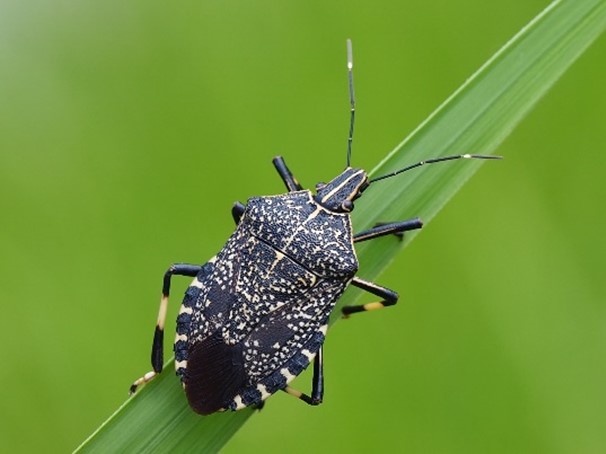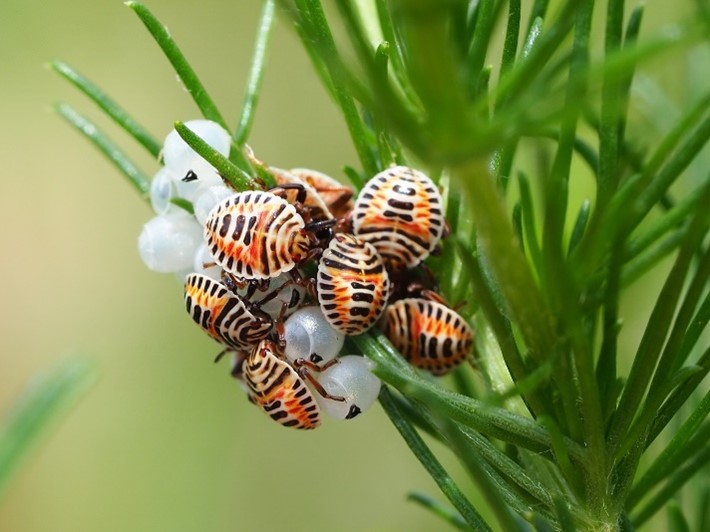Yellow spotted stink bug
An exotic pest – not wanted in Australia
Yellow spotted stink bug (YSSB) (Erthesina fullo) poses a serious threat to many commercial fruit crops, including pome and stone fruit.
Keeping yellow spotted stink bug out of the country is a national priority.
Have you seen this pest?
- Adults are 18–23 mm long and 8–11 mm wide.
- Colour is dark brown to blackish, with yellow spots and yellow midline stripe on head and following segment. Abdomen sides have margin of alternating black and yellow markings. Legs are black, banded with yellow (Figure 1).
- Feeds on over 57 plant species, including many commercial fruit crops, willow and pine trees.
- Feeding causes fruit discolouration, blemishes and withering and defoliation of plants.

What should I do?
- Report it immediately.
- Share your photos with us using the online public reporting form.
- Call the Exotic Plant Pest Hotline on 1800 084 881 .
- Please take good-quality photos of the pest and/or damage to include in your report. For tips, see the How to take good photos for a report guide.
Why is it a pest of concern?
Yellow spotted stink bug is an exotic sap-sucking pest which feeds on over 57 host plants in 29 plant families, including many economically important fruit crops.
Feeding by this pest causes discolouration, appearance of yellowish-brown spots, withering and even defoliation of leaves or shoots. Below the surface of feeding sites on fruit dry corky tissues can develop that harden, distorting the surface of the fruit, which reduces its marketability. In severe cases it causes fruit drop and significant yield loss. Other damage includes withering and defoliation of leaves and shoots, yellow or white blotches on leaves, aborted seeds and buds, and black pits on nuts.
Feeding enables infestation by bacterial and fungal pathogens, resulting in fruit rot and other secondary diseases.
Adults are a nuisance pest due to their overwintering (hibernating) behaviour where large numbers will seek shelter inside buildings for protection from the cooler weather.
Yellow spotted stink bug is very similar in appearance to another exotic pest – the brown marmorated stink bug – which is also a high priority pest of concern that should be reported if seen.
Where to look
Adult bugs will feed on host trees’ leaves, shoots, flowers and fruit.
Overwintering adult bugs can be found under bark or fallen leaves, in tree holes or seeking shelter inside buildings.
Young instars, or nymphs, feed on weeds or grasses and as they develop and migrate, they feed on fruits, leaves, and stems of the plant.
Eggs are laid in masses of about 12 on the underside of leaves on host plants.


Pest profile
Appearance
- Adult: Measures between 18 and 23 mm long and 8–11 mm wide. It has a dark brown to blackish body with yellow spots and a yellow midline stripe on the head and following segments. The sides of the abdomen have an alternating margin of yellow and black markings. Legs are black, banded with yellow. Males are smaller than females.
- Nymph (juvenile): Newly hatched nymphs are elliptical in shape with red, white, and black stripes (Figure 2). They undergo 5 moulting stages (called instars). Later instars are reddish brown to dark brown with a yellow or yellowish-red vertical line from the front of the head to the middle of the body. Pale red spots are present on the body (Figure 3).
- Egg: Newly laid eggs start off a light greenish colour and become light brown, then faint yellow before hatching. Eggs are 2.9 mm long and 1.7 mm wide (Figure 2).
Host plants in Australia
Overseas it feeds on over 57 known plant species, including many commercially grown fruits such as apple, apricot, cherry, plum, loquat, peach, pear, quince, kiwifruit, pomegranate, persimmon, macadamia and grape. Other hosts include beet, castor oil plant, black locust, mulberry, pine, plane trees, bamboo, poplars, willow, Paulownia, tree-of-heaven and elm. Potential native hosts are unknown.
Life cycle
- The life cycle from egg to adult varies depending on temperature, with an average of about 75 days. Adults will leave their overwintering sites when temperatures reach above 13° C. The development of eggs occurs between 15° C and 30° C.
- One or 2 generations per year is typical, with adults overwintering at the end of autumn and dispersing up to 3 km the following spring, when feeding, mating and egg laying begins.
Distribution and dispersal
- Native to east and south-east Asia, including Bangladesh, China, India, Indonesia, Japan, Myanmar, Sri Lanka, Taiwan, Hong Kong, Malaysia, Pakistan, Thailand and Vietnam. Recently established in Europe (Albania) in 2017 and South America (Brazil) in 2020.
- Known as a hitchhiker pest, YSSB can enter Australia carried on passengers, in luggage or within shipping containers, general cargo, machinery and vehicles.
- Imported host plants can also harbour egg masses, juveniles or adults.
Prevention
- Be vigilant and monitor imported host plants and goods from yellow spotted stink bug countries to prevent the introduction of this pest.
- Travellers returning from overseas should be aware and on the lookout for this pest in their luggage.
Image credits
- Figures 1 and 2: iNaturalist.
- Figure 3: Ryotaro Suzuki (iNaturalist) CC BY-NC.
Reporting an unusual plant insect pest or disease
Report any unusual plant pest or disease immediately using our online reporting form or by calling the Exotic Plant Pest Hotline on 1800 084 881. Early reporting increases the chance of effective control and eradication.
Please take multiple good quality photos of the pests or damage to include in your report where possible, as this is essential for rapid pest and disease diagnosis and response.
Your report will be responded to by an experienced staff member, who may seek more information about the detection and explain next steps.
Report online